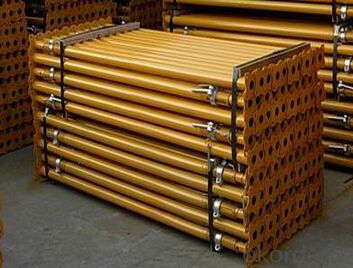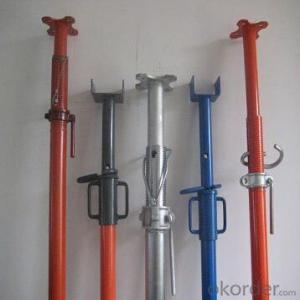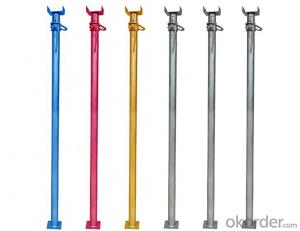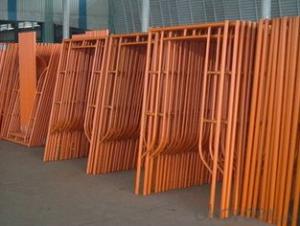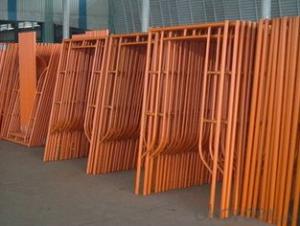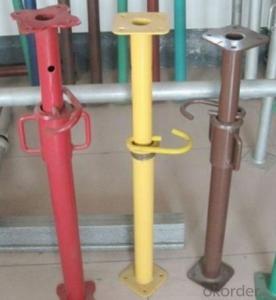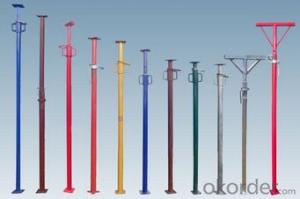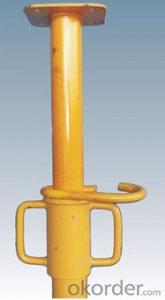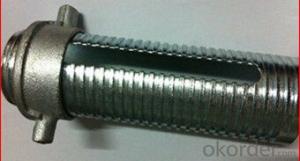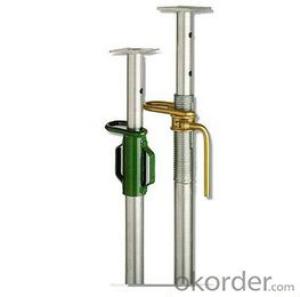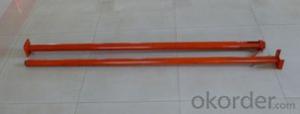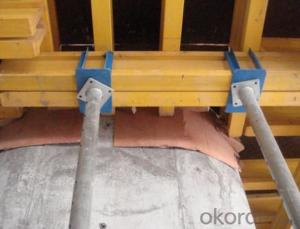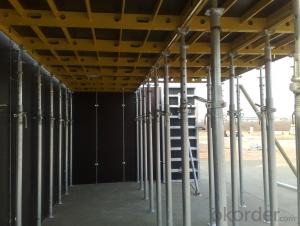Scaffolding steel prop pipe
- Loading Port:
- China Main Port
- Payment Terms:
- TT OR LC
- Min Order Qty:
- -
- Supply Capability:
- -
OKorder Service Pledge
OKorder Financial Service
You Might Also Like
Quick Details
| Place of Origin: | Model Number: | ||||
| Type: | Scaffolding Part Type: | weight: | |||
| color: | surface treatment: | advantage: | |||
| quality: | size: |
Packaging & Delivery
| Packaging Detail: | frame scaffolding steel pallet,in bulk |
| Delivery Detail: | within 15-20 days after getting the order |
Specifications
steel acrow props
1. Q235 stainless steel
2.factory directly
3.OEM services
4. heavy duty&galvanized
Item | Descrip- tion | Lengthm | External Tubemm | Internal tubemm | Weight (kgs) |
No1 | Spanish Props | 0.8-1.4 | 48×1.6×765 | 40×1.8×835 |
|
1.6-3.0 | 48×1.6×1600 | 40×1.8×1600 | 7.05 | ||
2.0-3.5 | 48×1.6×1716 | 40×1.8×2000 |
| ||
2.2-4.0 | 48×1.6×2000 | 40×1.8×2200 |
| ||
No2 | Italian Props | 1.6-2.9 | 56×1.6×1524 | 48×1.8×1600 | 8.81 |
1.8-3.1 | 56×1.6×1524 | 48×1.8×1800 | 9.21 | ||
2.0-3.6 | 56×1.6×1750 | 48×1.8×2000 | 10.2 | ||
2.2-4.0 | 56×1.6×2024 | 48×1.8×2200 | 11.05 | ||
No3 | German Props | 1.4-2.7 | 60×2.85×1396 | 48×3.2×1400 | 14.5 |
1.6-2.7 | 60×2.7×1550 | 48×3.2×1600 | 13.1 | ||
1.62-2.64 | 60×2×1396 | 48×32×1610 | 10.5 | ||
2.0-3.5 | 60×2.85×1900 | 48×3.2×2000 | 16.1 | ||
2.2-4.0 | 60×3×1900 | 48×3.5×2200 | 19.27 | ||
2.9-5.5 | 60×3.2×2680 | 48×3.2×2900 | 27.36 |
- Q: Can steel props be used in the construction of tunnels or underground passages?
- Tunnels or underground passages can indeed utilize steel props. These props, frequently employed in construction projects like tunnels and underground passages, serve as both temporary and permanent support systems. Their purpose is to ensure stability, strength, and load-bearing capacity, thus guaranteeing the structure's safety during construction and in the long run. Given their adjustability, steel props are easily installed and removed, making them suitable for a variety of underground construction applications. Furthermore, steel, being both durable and robust, can withstand the challenging conditions often encountered in tunneling projects, such as high pressure, ground movements, and vibrations. In summary, steel props are a dependable and widely used solution for supporting tunnels and underground passages during construction.
- Q: Are steel props suitable for supporting temporary trade show displays?
- Yes, steel props are suitable for supporting temporary trade show displays. Steel is a strong and durable material that can provide the necessary support and stability required for trade show displays. It is often used in construction and exhibition industries due to its reliability and ability to withstand heavy loads.
- Q: How are steel props installed and removed?
- Steel props, also known as steel acrow props or adjustable props, are commonly used in construction and formwork applications to provide temporary support. They are installed and removed following a specific procedure. To install steel props, the following steps are typically followed: 1. Preparation: Ensure that the area where the props will be installed is clear and free from any obstacles. Measure the required height and select the appropriate size of the steel props. 2. Positioning: Place the base plate of the prop on a solid and level surface, such as concrete or timber. Ensure that the base plate is securely positioned to prevent any movement during use. 3. Adjusting: Extend the inner tube of the prop to the desired height. Most steel props have a pin system or a threaded collar that allows for easy adjustment. Make sure the prop is set at the correct height to provide adequate support. 4. Tightening: Once the prop is adjusted to the desired height, tighten the collar or insert the locking pin to secure the inner tube in place. This will prevent the prop from collapsing or sliding during use. To remove steel props, the following steps are typically followed: 1. Loosening: Start by loosening the collar or removing the locking pin that secures the inner tube in place. This will allow the prop to be adjusted or collapsed. 2. Adjusting or collapsing: If the prop is adjustable, gradually lower the inner tube by turning the collar or releasing the pin. If the prop is not adjustable, collapse the prop by pushing the inner tube down. 3. Removal: Once the prop is adjusted to its lowest position or fully collapsed, carefully lift it off the base plate. Ensure that no one is standing directly underneath or in the vicinity of the prop during removal to prevent any accidents. 4. Storage: Store the props safely and securely in a designated area to prevent damage or injury. Ensure that they are kept in a dry and well-ventilated space to avoid rusting or deterioration. It is important to follow safety guidelines and manufacturer's instructions when installing and removing steel props. Regular inspection of the props for any signs of damage or wear is also recommended to ensure their safe and effective use.
- Q: What are the safety precautions when using steel props?
- When using steel props, it is important to take certain safety precautions. Firstly, always ensure that the props are of the correct size and load-bearing capacity for the specific application. Regularly inspect the props for any signs of damage, such as cracks or bends, and replace them if necessary. When setting up the props, make sure they are securely placed on a stable and level surface. Use proper bracing techniques to prevent any accidental movement or collapse. It is crucial to follow the manufacturer's instructions for the safe installation and removal of steel props. Lastly, never overload the props beyond their recommended capacity and always use appropriate personal protective equipment, such as gloves and safety shoes, to prevent any potential injuries.
- Q: Are steel props suitable for supporting temporary flooring or decking?
- Steel props, also referred to as adjustable steel props or acrow props, are an ideal option when it comes to providing support for temporary flooring or decking. Their usage is particularly common in construction projects where temporary structures like floors, decks, and scaffolding need reinforcement. These props are crafted from robust and long-lasting steel, which enables them to offer a secure and steady foundation for temporary flooring or decking. Moreover, their adjustable feature allows them to be modified to different heights, making them adaptable and versatile to meet various construction requirements. Furthermore, steel props are specifically designed to endure heavy loads, ensuring the safety and stability of the temporary structure. Consequently, steel props emerge as a dependable choice for supporting temporary flooring or decking in construction projects.
- Q: Can steel props be used for temporary support during curtain wall installation?
- Yes, steel props can be used for temporary support during curtain wall installation. Steel props are commonly used in construction to provide temporary support and stability to structures during various stages of construction, including the installation of curtain walls. They are adjustable in height and can be easily installed and removed as needed. Steel props are strong and stable, capable of bearing heavy loads, making them suitable for supporting the weight of curtain walls during installation. Additionally, steel props can be adjusted to provide precise support, ensuring that the curtain wall is installed accurately and securely. Overall, steel props are a reliable and commonly used method for providing temporary support during curtain wall installation.
- Q: Are steel props suitable for use in high-rise buildings?
- Yes, steel props are suitable for use in high-rise buildings. Steel props, also known as steel shoring or scaffolding props, are commonly used in construction projects, including high-rise buildings. These props provide essential support and stability to the structure during various stages of construction. Steel props are known for their strength, durability, and load-bearing capacity, making them suitable for supporting the weight and height of high-rise buildings. They are designed to withstand heavy loads and provide temporary support to the floors and walls during construction. Additionally, steel props can be easily adjusted and customized to fit different heights and angles, allowing for flexibility in construction. This adaptability is crucial in high-rise buildings, where different levels may require different support heights. Moreover, steel props are highly versatile and can be used in various construction scenarios, such as supporting concrete slabs, beams, or formwork. Their ease of installation and dismantling makes them efficient and cost-effective for use in high-rise buildings. Furthermore, steel props are often made from high-quality materials and undergo rigorous testing to ensure their safety and reliability. They comply with industry standards and regulations, providing reassurance in their suitability for use in high-rise buildings. However, it is important to note that the specific requirements and design considerations of each construction project should be taken into account when determining the suitability of steel props. Consulting with structural engineers and following the appropriate guidelines and codes is essential to ensure the safe and effective use of steel props in high-rise buildings.
- Q: How do you ensure proper bracing when using steel props?
- Proper bracing is essential when using steel props to ensure the stability and safety of the structure. Here are some steps to ensure proper bracing: 1. Plan and design: Start by carefully planning and designing the bracing system based on the specific requirements of the project. Consider factors such as load capacities, height, and stability requirements. 2. Assess the load: Determine the expected load that the steel props will be supporting. This will help in selecting the appropriate props with the right load-bearing capacity. 3. Positioning: Position the steel props at the correct locations to provide maximum support and stability. Ensure that the props are placed at equal distances and aligned properly to distribute the load evenly. 4. Secure connections: Make sure that the connections between the props and the structure they are supporting are secure and strong. Use suitable connectors such as pins, wedges, or bolts to firmly attach the props to the structure. 5. Use diagonal bracing: Diagonal bracing is essential to provide lateral stability. Install diagonal braces between the props and the structure, forming a rigid triangular configuration. This will help prevent any lateral movement or collapse. 6. Check alignment: Regularly check and ensure that the steel props are properly aligned and plumb. Any misalignment can compromise the stability and safety of the structure. 7. Regular inspections: Carry out regular inspections to monitor the condition of the props and bracing system. Look for signs of wear and tear, damage, or any signs of instability. Replace or repair any faulty or damaged components immediately. 8. Follow manufacturer guidelines: Always follow the manufacturer's guidelines and instructions for the proper use and maintenance of the steel props. Adhering to these guidelines will ensure that the props are used correctly and safely. By following these steps and taking the necessary precautions, you can ensure proper bracing when using steel props, minimizing the risk of accidents and ensuring the stability of the structure.
- Q: How do steel props compare to screw jacks in terms of stability?
- Steel props and screw jacks are both commonly used for providing temporary support during construction activities. In terms of stability, both steel props and screw jacks have their advantages and limitations. Steel props, also known as adjustable props or acrow props, are usually made of steel tubes with a threaded end and a removable pin. They are typically used to support vertical loads and provide stability to structures during construction. Steel props offer excellent stability due to their robust construction and ability to withstand heavy loads. They are generally more suitable for supporting larger structures or heavy loads, as they have a higher load-bearing capacity compared to screw jacks. Screw jacks, on the other hand, consist of a threaded rod and a large plate that rests on the ground or a suitable base. They are commonly used for leveling or supporting smaller structures. Screw jacks provide stability by adjusting the height of the rod, allowing for precise leveling or support. While screw jacks are generally stable, their load-bearing capacity is lower compared to steel props. They are typically used for lighter loads or when precise adjustments are required. In summary, steel props and screw jacks both offer stability, but their suitability depends on the specific requirements of the construction project. Steel props are more suitable for supporting larger structures or heavier loads, while screw jacks are often used for smaller structures or when precise adjustments are needed. It is essential to consider the load requirements, the size of the structure, and the desired level of stability when choosing between steel props and screw jacks.
- Q: Do steel props have any height indicators for easy adjustment?
- Yes, steel props typically have height indicators for easy adjustment. These height indicators are often marked on the outer surface of the prop and are used to determine and set the desired height of the prop. This allows for quick and accurate adjustment of the steel prop to match the required height for supporting structures during construction or renovation projects. The height indicators can be in the form of numbers, lines, or other visual markings that indicate the different height positions. These indicators help ensure that the steel props are correctly set to provide optimal support and stability while also making it easier for construction workers to adjust and align the props as needed.
Send your message to us
Scaffolding steel prop pipe
- Loading Port:
- China Main Port
- Payment Terms:
- TT OR LC
- Min Order Qty:
- -
- Supply Capability:
- -
OKorder Service Pledge
OKorder Financial Service
Similar products
Hot products
Hot Searches
Related keywords



